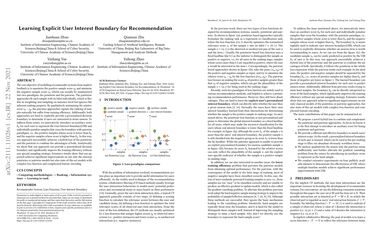Learning Explicit User Interest Boundary for Recommendation
The core objective of modelling recommender systems from implicit feedback is to maximize the positive sample score $s_p$ and minimize the negative sample score $s_n$, which can usually be summarized into two paradigms: the pointwise and the pairwise. The pointwise approaches fit each sample with its label individually, which is flexible in weighting and sampling on instance-level but ignores the inherent ranking property. By qualitatively minimizing the relative score $s_n - s_p$, the pairwise approaches capture the ranking of samples naturally but suffer from training efficiency. Additionally, both approaches are hard to explicitly provide a personalized decision boundary to determine if users are interested in items unseen. To address those issues, we innovatively introduce an auxiliary score $b_u$ for each user to represent the User Interest Boundary(UIB) and individually penalize samples that cross the boundary with pairwise paradigms, i.e., the positive samples whose score is lower than $b_u$ and the negative samples whose score is higher than $b_u$. In this way, our approach successfully achieves a hybrid loss of the pointwise and the pairwise to combine the advantages of both. Analytically, we show that our approach can provide a personalized decision boundary and significantly improve the training efficiency without any special sampling strategy. Extensive results show that our approach achieves significant improvements on not only the classical pointwise or pairwise models but also state-of-the-art models with complex loss function and complicated feature encoding.
PDF Abstract


 MovieLens
MovieLens